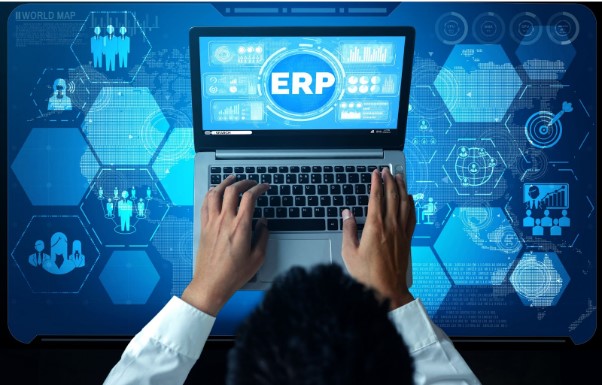With constant changes in the business scenario, technological resources are increasingly relevant to maintain competitiveness and drive the growth of organizations.
Among these technologies, the ERP system stands out as a great option. This business administration software
However, the local implementation of this system can often be costly and require maintenance. Given this scenario, migrating the ERP system to the cloud becomes a solution.
And according to research by Gartner , it is estimated that by 2025 at least 85% of organizations will be using cloud computing for their activities.
Therefore, in this post, we will present ERP, with its features and advantages, but we will also explore the strategic relevance of moving the system to the cloud.
Stay with us!
What is an ERP system?
An ERP (Enterprise Resource Planning) system is a business management that integrates and simplifies access to data from different areas of a company.
It centralizes information on a single platform, facilitating access to insights, decision making and, consequently, improving operational efficiency.
ERP is recognized as a facilitator for:
- optimize internal processes;
- integrate departments;
- and improve decision making.
Main modules of an ERP
ERP systems are made up of different modules that integrate to provide a complete solution. Look:
- Finance: management of accounting, budgeting and financial reporting.
- Human Resources: payroll administration, benefits and recruitment.
- Stock: inventory control and product tracking.
- Sales: automation of the sales process and order management.
- Purchasing: supplier management and material acquisition control.
An ERP brings everything together in a single interface, eliminating the need for multiple disconnected systems and enabling a unified view of the company's results.
Furthermore, it is important to highlight that it is possible to customize the tool’s functionalities according to your organization’s needs.
How does an ERP system work?
As previously described, an ERP is an administration system capable of controlling different areas of the company in an integrated way.
In practice, it works as an information center , bringing together data from departments into a single system, promoting efficient communication and collaboration between sectors.
Through systems integration , ERP eliminates repetitive manual tasks and automates workflows, optimizing operational efficiency.
See below a little more about the topic:
Process integration
Integration is the foundation of an ERP . All company departments are connected, allowing information to flow seamlessly between them. This eliminates data redundancy and improves internal communication.
For example, a purchase order initiated by the sales department can be automatically transmitted to production and finance. This minimizes errors and ensures organization.
Data collection and analysis
Another fundamental point is data collection and analysis. An ERP system is designed to collect information from different areas and store it in a centralized database, facilitating access and analysis in real time.
From there, reporting tools and dashboards offer insights into the performance of each area of the company. This way, managers and executives can make informed decisions based on data .
Task automation
Another function of ERP is the automation of manual and repetitive tasks.
Tasks such as invoicing, payroll processing and inventory management can be automated , freeing up time for employees to focus on more relevant activities.
This not only increases efficiency , but also reduces the possibility of human errors. For example, through the use of an ERP system, manual form filling can be eliminated, allowing tasks to be completed faster and more accurately.
Benefits of using an ERP system
Now that we understand the main functions of an ERP system, the time has come to see the benefits linked to its implementation.
By adopting an ERP system, companies are able to optimize their resources, improve operational efficiency and make decisions based on concrete data.
See in more detail:
Improved decision making
As the first benefit, we highlight the improvement in decision making . This happens because an ERP system allows access to accurate, real-time data from different sectors.
Companies can monitor department performance, identify problem areas , and take corrective action immediately.
This reduces dependence on unfounded assumptions and opinions, allowing for more objective and fact-based management.
Increased operational efficiency
Operational efficiency also increases significantly with the implementation of an ERP. Automatic processes eliminate redundant manual tasks and minimize human errors.
Furthermore, an ERP makes it possible to integrate various functions, such as accounting, sales and inventory management, into a single platform. This results in a reduction in rework and an acceleration of workflows.
Better resource management
When there is centralization of data and more clarity about information and processes, it becomes easier to better manage the company's resources.
This centralization facilitates inventory control, avoiding excesses and shortages, and improves financial planning by providing a comprehensive view of the company's finances.
Furthermore, human resources management also benefits, with modules that cover everything from recruitment to career development, ensuring that human capital is used strategically.
Differences between cloud ERP and on-premises ERP
So far we have seen the features and benefits of an ERP system , but did you know that this system can also be in the cloud?
And choosing between a cloud ERP and an on-premise ERP has a significant impact on operations, so in this section we will talk about the differences between each modality.
The big point is in the infrastructure. On-premises ERP requires the installation of dedicated servers and hardware within the company, while cloud ERP is hosted on remote servers accessible via the internet.
This eliminates the need for initial investment in expensive equipment, easing the financial burden.
Furthermore, cloud ERP offers automatic updates made by the provider, more flexibility and scalability.
Why migrate your ERP to the cloud?
As we began to see in the previous topic, adopting cloud ERP can bring significant advantages.
Among the immediate benefits are cost reduction, greater flexibility through remote access and simplified system updates and maintenance, which allows companies to direct financial and human resources to other strategic areas, such as innovation and business expansion.
Understand better below:
Reduction of infrastructure costs
By migrating to a cloud-based ERP system reduce the costs associated with purchasing and maintaining hardware.
Expensive on-premises servers and physical infrastructure are replaced with cloud storage .
Furthermore, energy and physical space costs also decrease, as there is no need for bulky equipment.
Remote access and flexibility
With the migration of ERP to the cloud, all you need is an internet connection and you can access the system and data from anywhere, at any time.
Flexibility is fundamental, especially in a world where remote work is a reality for so many organizations.
This facilitates collaboration between teams in different time zones and locations, making global operations management more cohesive.
Simplified updates and maintenance
Keeping an ERP up to date can be time-consuming and expensive if done in-house.
But with migration to the cloud, this responsibility falls to the service provider. Updates are made automatically , without the need for intervention from the company's IT team.
This ensures that the system always remains up to date with the latest features and security fixes.
Plus, simplified maintenance means less downtime and greater availability .
Steps to migrate your ERP to the cloud
Ok, we understand why to migrate an ERP to the cloud, but what about how?
This is a process that involves several steps. Each phase is important, so you need to develop a detailed migration plan to ensure a smooth transition and maximize the benefits of cloud computing .
Assessment of company needs
The first step is to assess the company's specific needs. This includes identifying which processes and data are critical to daily operations and mapping performance, security and compliance requirements. This mapping helps to define which ERP system should be prioritized when migrating to the cloud .
Additionally, you need to consider your current IT infrastructure and identify any potential gaps. Reviewing lessons learned from previous systems migrations can provide valuable insights.
Choosing a cloud provider
Here we are talking about a critical point. To choose the ideal provider, you must consider factors such as costs, scalability, reliability and technical support.
It's a good idea to compare different providers to assess which one offers the best services and support for your organization's specific needs.
Additionally, investigating the provider's experience with ERP migrations can be an important differentiator.
Migration planning and execution
Once the company's needs have been defined and the cloud provider has been chosen, it is time to carry out planning. Putting together a detailed plan is key to a successful migration
First, you must create a schedule that minimizes disruption to daily operations. This timeline should include clear steps and defined goals for each phase.
In execution, rigorous testing is essential. Therefore, it is necessary to carry out tests in simulation environments or sandboxes to identify and resolve problems before the complete change.
Additionally, ensuring backups of all data is another critical step to prevent information loss during the transition.
Training and adaptation
Finally, it's time to train the team. A cloud ERP can have significant differences compared to the local system, and the team must be prepared for these changes. Investing in specific training on the new features and processes of cloud ERP makes adaptation easier.
Another possibility is creating an adaptation phase where the team can use the new system in parallel with the old one that can help smooth the transition.
During this period, it's important to collect feedback and adjust processes as needed to ensure successful adoption.
Your ERP in the cloud with Skyone
Now that you've seen everything about ERP and the benefits of migrating this system to the cloud, it's time to put your knowledge into practice. And there’s nothing better than having a partner specialized in the subject to help you in this process.
Here at Skyone we have solid experience in cloud solutions, covering migration, management and storage.
Our platform has a cloud computing module where we have Skyone Autosky , a product that has everything needed to migrate, manage and orchestrate software and cloud servers safely – and without headaches.
Are you interested? Request a demo!
Conclusion
As pointed out throughout this post, an ERP system is a powerful tool for integrating and automating a company's processes, centralizing information and facilitating decision making.
And migrating this system to the cloud further enhances its benefits, as it offers remote access, cost reduction, automatic updates, scalability and security.
If your company has not yet considered this migration, perhaps it is time to explore this possibility and take advantage of all the advantages that the cloud has to offer.
To learn more about the topic, read our special guide on ERP!




